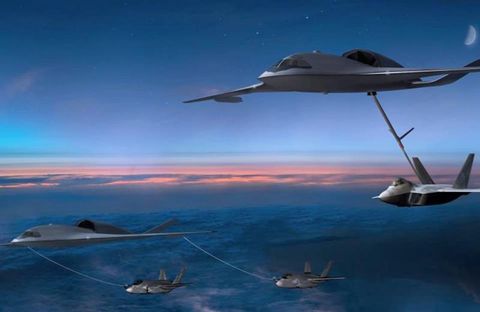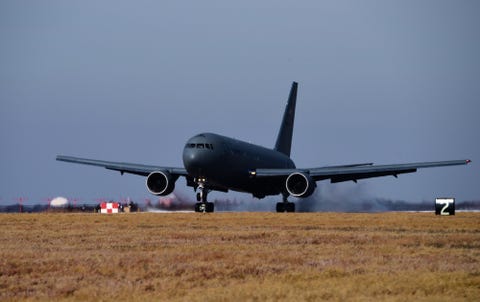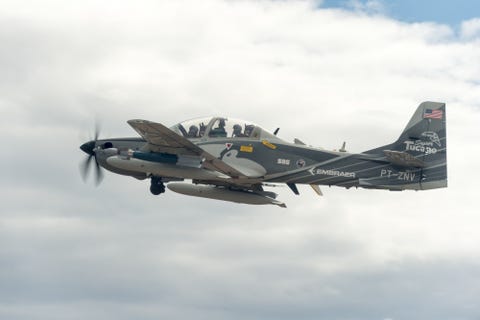The U.S. Air Force May Not Buy New Stealth Tanker After All, and the Light Attack Aircraft Could be Dead Too
The service appears to be trimming expectations to meet operational realities, budgets. But what's this thing about space tankers?
By Kyle Mizokami LOCKHEED MARTIN
LOCKHEED MARTINThe U.S. Air Force may not buy a stealthy tanker after all, dashing hopes of a radar-invisible refueling plane that could fly close to the aerial front line. Meanwhile, the service also announced its new OA-X light attack aircraft program is on indefinite hold. It would seem the Air Force is cutting back programs to reflect changing the changing global landscape and the fact that USAF has a number of other, higher priorities in the form of new aircraft and missiles.
Air Force Chief of Staff Dave Goldfein, in remarks to Aviation Week & Space Technology, said regarding a stealth tanker, “The days of buying individual platforms that we then described as game changers—those days are behind us. There actually are no silver bullets on the horizon.”
Tanks a Lot

KC-46A Pegasus.
U.S. AIR FORCE PHOTO BY AIRMAN 1ST CLASS SKYLER COMBS
As we reported earlier this week, the Air Force has finally received the first of its KC-46A Pegasus aerial refueling tankers, which are intended to finally replace the decades-old KC-135 Stratotankers. The Pentagon planned to supplement the KC-46 with an entirely new aircraft, the KC-Z.
Unlike the KC-46A, KC-Z would have been a stealthy tanker capable of flying closer to the aerial front line to support warplanes such as the F-22 Raptor, F-35 Joint Strike Fighter, and B-21 Raider bomber. It's important because America's tankers would become a target in any future war. The Chinese military would plan to target not only fighters and bombers but also the support assets they rely upon, including tankers and AWACs-style command and control planes.
But building the KC-Z would have been a very expensive endeavor. For one thing, other than the B-2 Spirit there are no large, stealthy airframes ready to convert into tanker. This would have necessitated a long and expensive development period for what would essentially be a flying gas tank. (Of course, one possibility is that KC-Z would be based on the forthcoming B-21 Raider, with bombs replaced with internal fuel storage.)
And the USAF budget it getting crowded. Over the next 15 years, the Air Force must also build the B-21 Raider bomber, stock up on the F-35 Joint Strike Fighter, purchase the T-X jet trainer, develop the Penetrating Counter Air sixth-generation fighter, and develop and field the next-generation intercontinental ballistic missile, the Ground-Based Strategic Deterrent. Each of these programs would cost in the tens of billions of dollars.
How the Air Force will pay for all of those, much less the development of a stealthy tanker, is a very good question. If the Air Force replaces all its existing KC-135 and KC-10 tankers with new ones, it would need 455 new tankers. The Air Force originally planned to buy 179 KC-46As. As problem-ridden as that plane has been, it seems quite possible that the Air Force might purchase hundreds more KC-46As to fully modernize the fleet.
The U.S. Air Force’s X-37B spaceplane.
DEPARTMENT OF DEFENSE
Then again, money might be less of a consideration than we think. In his interview with AvWeek, Goldfein remarked that his next generation tanker could “operate at low-Earth orbit” and that while it might sound “a little bit odd” for him to discuss a future tanker with Air Force Space Command, it makes “perfect sense.” What he means is anyone’s guess, but here’s a stab at something that could operate along those lines: a tanker that could stay in orbit for months or even years at a time, much like the X-37B spaceplane, and then descend down into airspace to deliver fuel to friendly aircraft before accelerating back up into the relative safety of orbit again. Whatever the case, it sounds exciting...and expensive.
Getting Lean
Another program the Air Force appears close to shedding is the Light Attack Aircraft, or OA-X. OA-X was a program to develop a light attack and observation aircraft for the Air Force for low intensity conflicts and brushfire wars—places where troops need precision firepower but do not face the modern, advanced air defenses that a near-peer like Russia or China could field.
The aircraft program, which had the backing of the late U.S. Senator John S. McCain, was set to be funded to the tune of approximately $1.2 billion and could have swelled to a fleet of 300 planes. The Air Force held a competition in 2018 to whittle OA-X down to two planes, the AT-6B Wolverine and A-29 Super Tucano, but a June crash that killed one pilot put the brakes on testing. In December 2018, the Air Force announced the program itself was indefinitely on hold.

A-29 Super Tucano.
U.S. AIR FORCE PHOTO BY ETHAN D. WAGNER
The test crash wasn't the only factor that may have killed the program. The OA-X planes were originally meant for wars such as the campaign against ISIS and the Taliban in Afghanistan. ISIS, although not totally beaten, has been cornered into a fairly small area and operations against the terrorist group are proceeding at a much slower pace. The recognition that the war in Afghanistan is 17 years old is driving new calls to finally end the conflict, and peace negotiations with the Taliban may well result in a U.S. withdraw. The Air Force, busy spooling up to fight major wars against big power enemies, may worry that buying OA-X could be spending money on the wars of the past—not the wars to come.
Source: Aviation Week & Space Technology

No comments:
Post a Comment